Hyaenas are tough, intelligent and co-operative predators which makes them very capable hunters and effective thieves. In our trip with CNP Safaris in January this year we saw an estimated 70 different lions in a week. lions and hyaenas co-exist in a dynamic balance between numbers and brute strength.
“A human being is a part of the whole called by us universe, a part limited in time and space. He experiences himself, his thoughts and feeling as something separated from the rest, a kind of optical delusion of his consciousness. This delusion is a kind of prison for us, restricting us to our personal desires and to affection for a few persons nearest to us. Our task must be to free ourselves from this prison by widening our circle of compassion to embrace all living creatures and the whole of nature in its beauty.” ~ Albert Einstein
Hyaenas on their own seem to be mostly scavengers but given the enormous bite strength other smaller predators from leopards downwards know not to take them on!
“Each of us is a unique strand in the intricate web of life and here to make a contribution.” ~ Deepak Chopra
Not taking them on, but showing a threat display can be useful if only for a short while. This Griffon vulture spreads its wings to make itself look bigger to the passing Hyaena mother and her youngster.
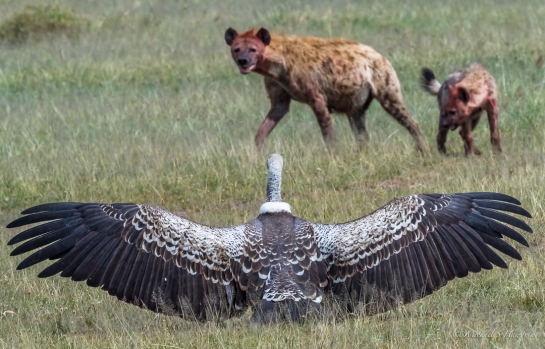
This clan member had been part of a group which had taken on the three young male lions which were part of a coalition of eight males. The lions appeared to have got the best of the carcass but Hyaenas are adept at picking up the remains.
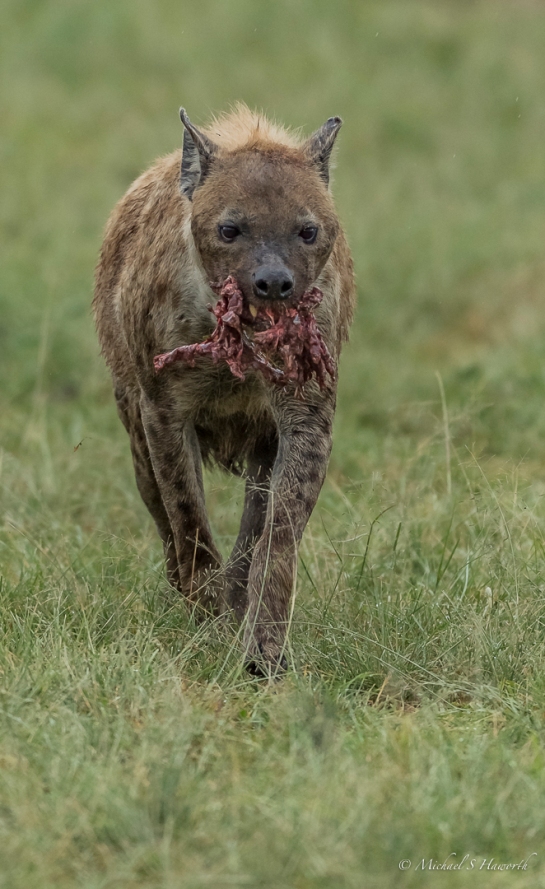
There is always aggressive competition for food in an Hyaena clan. Hyaenas cannot use their claws and paws when hunting the way lions do. The only thing Hyaenas can do is to bite and hang onto their prey. Hyaenas have exceptionally strong jaws and neck muscles enabling them to lock on with thier jaws. They also uses their jaws on each other with a devastating and permanent effect.
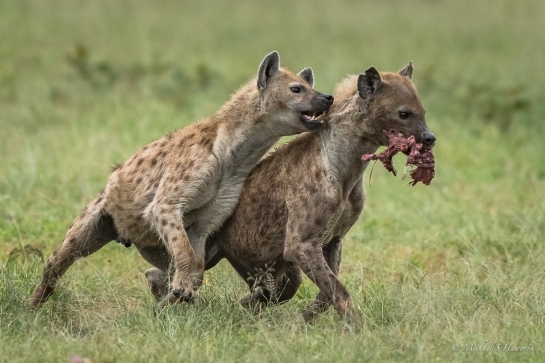
“The gossamer web of life, spun on the loom of sunlight from the breath of an infant Earth, is nature’s crowning achievement on this plant.”~ Preston Cloud
This particular Hyaena had retreated into the Nyasirori dam. I am not sure whether the retreat was from the lions or just to have a drink. The family of Egyptian geese watched the Hyaena’s antics from a safe distance in the middle of the dam.
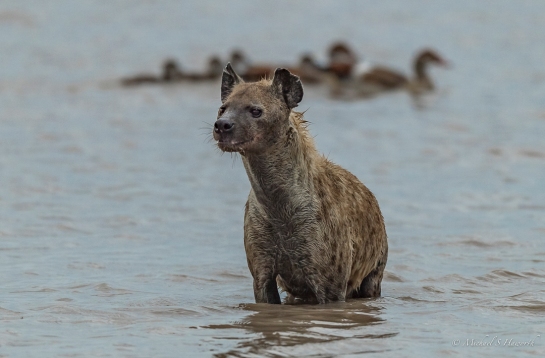
A little further on from the Nyasirori dam near the ‘Hyaena spa’ we found Hyaenas around a kill. The Hyaenas must have made the kill as there were no other predators anywhere around. The victim was a Topi, a cousin of the Hartebeest.

Topis do try to sleep in the middle of the day. They sleep in a crouched position in the grass in an open plain with their head down as if resting it on the ground. Hyaenas regularly wander through a Topi herd looking for a prey opportunity either in the form of a sleeping Topi or an injured one. A Hyaena must have seen the sleeping Topi and grabbed it. The Topi would have woken and tried to bolt but the Hyaena would have locked on. Other Hyaena scouts in the area must of seen the tangling Topi and Hyaena and run in to bite the Topi. In all likelihood the joining Hyaena would have been biting and tearing pieces off the alive Topi. Eventually is collapsed from trauma and loss of blood. Once down, the Hyaenas would be calling and others would come storming in to the kill.

Contrary to common belief, lions steal more kills from hyaenas than the other way around. Hyaenas are able to tear a carcass apart with their strong jaws. Everything goes, Hyaenas are able to eat the skin, bones and hooves.
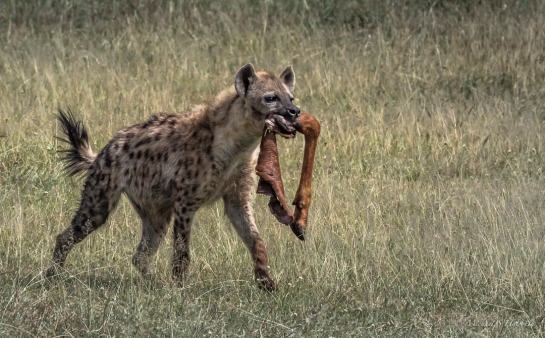
A large dog, such as a Mastiff or Rottweiler, has an average bite strength of 325 pounds per square inch. An African Lion has a bite strength of 650 pounds per square inch. A Bengal Tiger has a bite strength of 1,050 pounds per square inch. The Spotted Hyaena has a bite strength of 1,100 pounds per square inch. The only animals with a stronger bite force are Grizzly bears, Polar bears, Gorillas, Bull sharks, Jaguars, Hippos, and crocodiles (almost 5 x that of an Hyaena).

Given that Hyaenas do not have claws (grappling hooks) like lions. They are seldom able to grab their prey by the throat and choke it. More often, they grab it anywhere they can and hang on and eventually wear it down. If other members of the clan get involved they add to the biting and blood loss until the prey collapses and then the clan members eat the prey alive. As the next images shows they will take anything including a Topi’s head.

Lions and Hyaenas are arch enemies, a psychology engrained from when they were very young and on each other’s prey list. If a lioness will not give up a kill when mobbed by many Hyaenas they will try to kill her. Conversely, if a male lion sees Hyaenas harassing and trying to steal a kill from his lionesses he will attacked the Hyaenas and often kill at least one of them. The lion very seldom eats a Hyaena he has killed.
“All things are connected. Whatever befalls the Earth, befalls the children of the Earth.”~ Chief Seattle
Unfortunately Hyaenas have to also fear humans, even well inside the Serengeti National Park. Poachers set their snares along game paths obvious tunnels through the flora. They only check on the snares after a delayed period. The snares are indiscriminate killers and maimers.
“Because we do not think about future generations, they will never forget us.”~ Henrik Tikkanen
We found a mixed flock of vultures feeding on a dead Hyaena. On closer inspection it had a snare around its neck so must have starved and throttled itself to death as it tried to free itself from the wire noose.
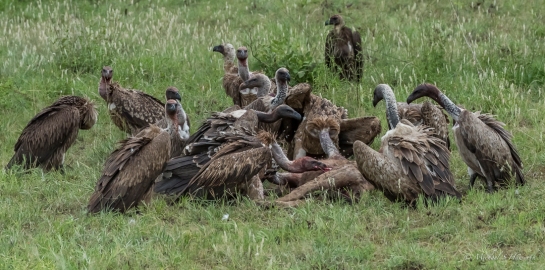
If you thought Hyaenas were not fussy eaters then vultures are even less fussy eaters. There were White-backed, Griffon and Hooded vultures around the carcass.

Two White-backed vultures trying to bite each other near the hyaena kill.
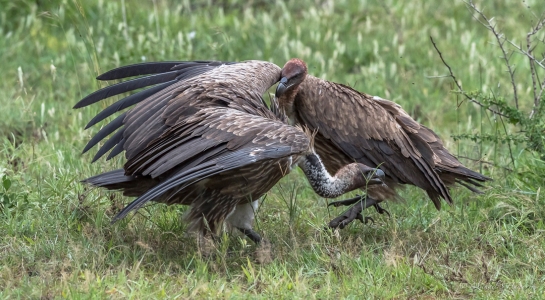
There was much squabbling among the vultures on the kill. The vultures went for the soft parts of the body first and especially the damaged area around the neck of the ensnared Hyaena.
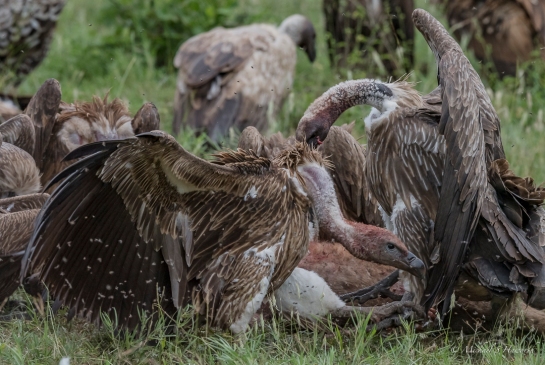
Griffons were the largest vultures on the carcass with White-backed vultures being slightly smaller. Much smaller than both the others are Hooded vultures. They tend to hand around the feeding frenzy picking up bits and pieces dropped by the others. The Hooded vultures do not have the bulk and strength to compete on the carcass.
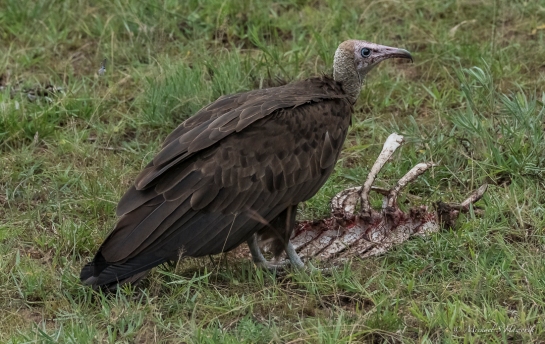
“Shallow ecology is anthropocentric, or human-centred. It views humans as above or outside nature, as the source of all value, and ascribes only instrumental, or ‘use’, value to nature. Deep ecology does not separate humans – or anything else – from the natural environment. It does see the world not as a collection of isolated objects but as a network of phenomena that are fundamentally interconnected and interdependent. Deep ecology recognizes the intrinsic value of all human beings and views humans as just one particular strand in the web of life.” ~ Fritjof Capra
A typical tussle between two Hyaenas where one member tries to intimidate the other to get them to drop the food in their mouths.
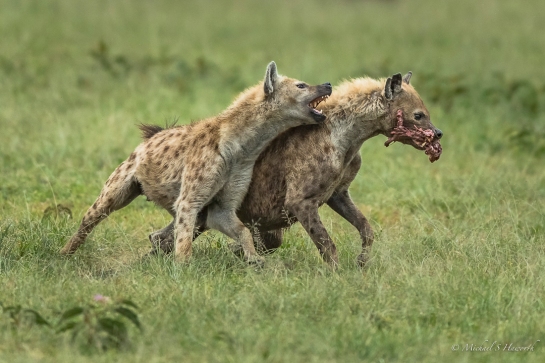
At night, a Hyaena’s whooping and their cackles will send shivers down your spine – a primal reaction. Hyaenas and vultures are crucial complementary members of nature’s clean up crew. They often need each other. Hyaenas, also known as bone crushers, will will open up a carcass which vultures can then take advantage. On the other side, Hyaenas watch the sky for vultures and often locate a kill by following them and watching where they descend. Between the two species they will clean an area of a kill and rid it of discarded bones and debris. Vultures and Hyaenas provide a vital healthcare role in the ecosystem by keeping it clean and reducing the incidence of disease. When Hyaenas are not around, vultures do an effective job of “cleaning the bones” of a kill but they cannot eat the bones. Although quite macabre, Hyaenas and vultures are nature’s effective “clean up” gang who keep the ecosystem dynamic and healthy.
“Humankind has not woven the web of life. We are but one thread within it. Whatever we do to the web, we do to ourselves. All things are bound together. All things connect.” ~ Chief Seattle
Explore, seek to understand, marvel at its inter-connectedness and let it be.
Have fun, Mike

You have provided interesting snippets of information along with your usual high standard of photography. This is a fine example of nature looking after itself – the ‘cleansing’ departments at work.
Baie interessant – dankie!